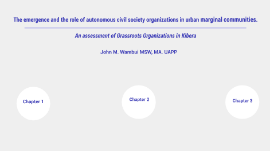Proposal Defense
Transcript: John M. Wambui MSW, MA. UAPP The emergence and the role of autonomous civil society organizations in urban marginal communities. An assessment of Grassroots Organizations in Kibera Chapter 1 Introduction What is a Community? and What are its most basic elements? Community .....is a group of people with diverse characteristics who are linked together by social ties, shared perspectives, a sense of social and cultural coherence, and engage in collective action in a given geographic location or setting (MacQueen et al., 2001). In this definition, three contextual characteristics of a community emerge i.e. Place, Interest, and Communion (Smith, 2001). A Community... Basic Elements Based on the established definition and core elements of a community, can a slum, a place too often considered chaotic and disorderly be defined as a community? A Slum as a Community? A slum as a place of metropolitan degradation and desolation Two Arguments of Slums Traditional Argument Statistical Dilemma Global slum population growing by an average of 6 million people per year since 2000 and 56% of this growth is taking place in Sub-Sahara Africa (PSUP, 2016). About 59% of urban population in Sub-Sahara Africa lives in slums (PSUP, 2016; World Bank Group, 2016). In Asia & Pacific, 28% of urban residents reside in slums. In Latin America & Caribbean region, 21% of urban population reside in slums. Today, around 1 billion people live in slums accounting for 1 in 8 people (PSUP, 2016). This population is projected to double by 2030 with much of the increase taking place in developing nations. Need for an alternative view of slums Viewed from inside, a slum presents a highly organized and integrated social system (Whyte, 1943) There is a need to understand how a slum function as a social system (Jacobs, 1992; Bayat, 2007) A slum as a place of metropolitan innovation and collective ingenuity Contemporary Argument Slum as a Community In this study, I define a slum as a community where people share common experiences, norms, habits, interests, and communion among other traits. Body of literature defining a slum as a coherent community (Boo, 2012; Gilbert, 2007b; Jacobs, 1992; Neuwirth, 2006; Roy, 2011). To solve slum's challenges, there is a need to understand how people living there collectively organize to address common vulnerabilities (Bayat, 2007; Coleman, 1990; Field, 2003; Holston & Caldeira, 2008; Jacobs, 1992; Putnam, 2000; Whyte, 1943) Research Questions Research purpose is to: Explore how the local community in slums navigate prevailing environmental vulnerabilities through collective actions and local mobilization techniques. Highlight how local creativity, innovation, resilience, and adaptability compose skill-sets that enable households in slums to navigate diverse social and environmental vulnerabilities particularly in the areas of sanitation, health, education, and employment. Using local grassroots networks as proxies for local imagination and collective ideology, the study is guided by the following three research questions. Research Questions @ John Wambui (2016) "Research is creating new knowledge" Neil Armstong Research Significance Bridge the gaps in both theoretical and policy understanding of slums. Scholarly contribution to the existing body of knowledge particularly in commuity development. Professional development in the field of academia and social policy. Evaluative purpose-Highlights the role of grassroots organizations in community development. Extensive body of literature and theories exist highlighting the importance of civil society organizations in community development Literature Review Chapter 2 Literature Diverse social organizations emerge to serve diverse purposes: Some emerge as instruments for social, economic, political, and cultural mobilization (Coleman, 1990; Putnam, 2000; Bourdieu, 1984; Loury, 1977; Whyte, 1943). Others emerge to initiate, maintain, or disrupt the status quo (Morrison, 1987). Some emerge to protect certain social and spatial identities (Whyte, 1943). And others (as conceptualized in this study) emerge to highlight the collective ideology, creativity, and innovation. In the context of slums, formal and informal social networks highlight social coherence and self organization in a place too often considered chaotic and disorderly (Whyte, 1943; Jacobs,1992; Holston, 2008: Holston and Caldeira, 2008; Kayizzi-Mugerwa et al., 2014). Social networks, especially grassroots initiatives are perceived as alternative suppliers of public goods and services in areas where state fails as a provider (Abdul-Raheem, 1996; Heller, 1996; Ostrom, 1990; Ostrom, 1996; Wilson, 1987). Existing Literature Investment in education by different organizations in Kibera Three critical factors are necessary for the formation of civil society organizations (Fox, 1996) Political opportunities for collective action (referrred as activators in this dissertation) Social energy and ideas that motivate reactions

















